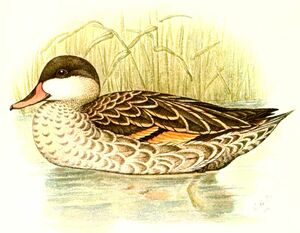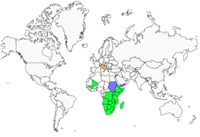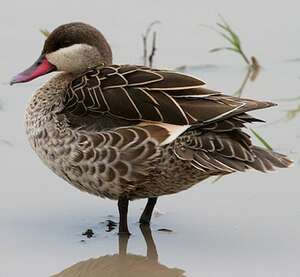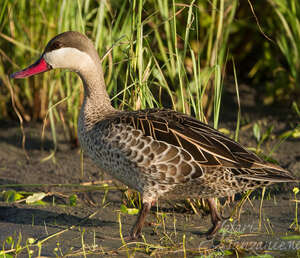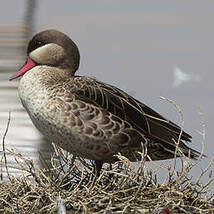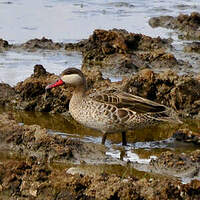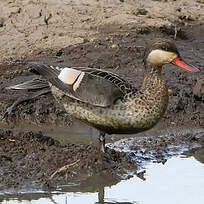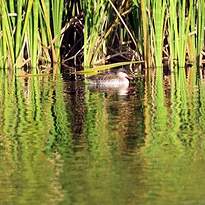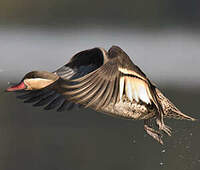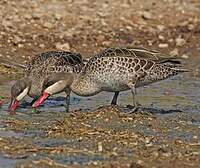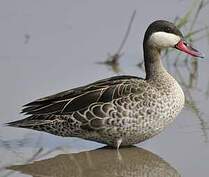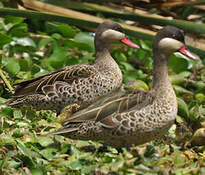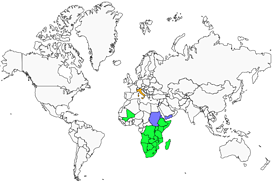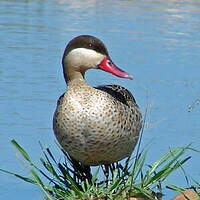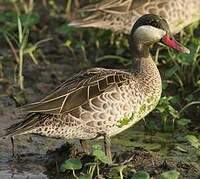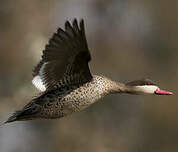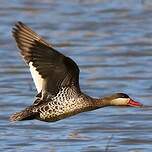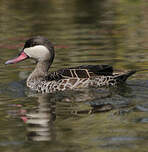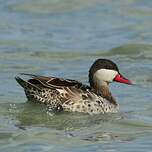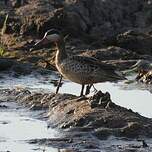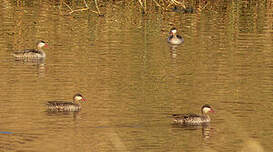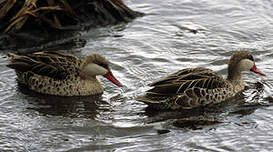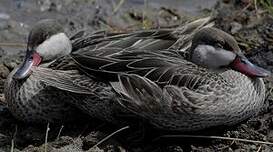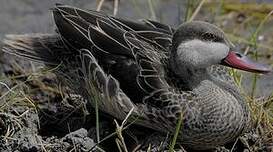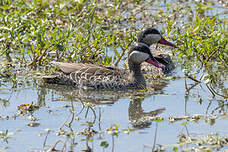Red-billed Teal
Anas erythrorhyncha - Canard à bec rouge
Identification
The Red-billed Teal is a small surface duck of the Anas genus, which includes the teals. English speakers call it the Red-billed Teal, whose French name is an exact translation. This small duck is recognizable by its head, the most contrasted part of its body, which is typical of the species. A clearly defined dark brown band starts at the upper base of its bill and extends to the back of its neck. This contrasts with the pale ochre cheeks. Of course, the pinkish red bill with a black line on the ridge and a dark brown tab. The eye is brown-black. The upper parts, including the wings, are brown-black with fine light ochre laces. The neck and underside to the tail are white spotted more or less coarsely with light brown. The sides are more broadly with a scaly appearance. In flight, the secondary remiges and the tips of the large light ochre coverts form a clearly visible light area. The legs are slate gray. The two sexes are similar. The only small difference is in the intensity of the bill's red, a little brighter in the male and in size, a little greater in the latter. The breeding male is not distinguished from the non-breeding male. Indeed, even after the molt which takes place after the breeding season, there is no eclipse plumage. The young bird is darker, duller, redder, with a bluish bill and a brown area on the side of the neck.
Subspecific information monotypic species
Foreign names
- Canard à bec rouge,
- Ánade piquirrojo,
- marrequinha-de-bico-vermelho,
- Rotschnabelente,
- piroscsőrű réce,
- Roodsnavelpijlstaart,
- Anatra beccorosso,
- rödnäbbad and,
- Rødnebband,
- kačica červenozobá,
- ostralka rudozobá,
- Rødnæbbet And,
- punanokkasorsa,
- Rooibekeend,
- ànec bec-roig,
- Mýrönd,
- rożeniec czerwonodzioby,
- sarkanknābja pīle,
- rdečekljuna raca,
- Красноклювая шилохвость,
- アカハシオナガガモ,
- 赤嘴鸭,
- 赤嘴鴨,
Voice song and cries
Habitat
The habitat of the Red-billed Teal is represented by open wetlands of the interior, water bodies with a minimum of floating and emergent vegetation, flooded rice fields, marshes. It is rare on the coast and remains far from large estuaries in Africa. In Madagascar it occupies the entire island, from the coast up to 2,000 m altitude.
Behaviour character trait
The Red-billed Teal is a surface duck, it paddles but does not dive. It is gregarious outside of the breeding season.
Sedentary, it can travel long distances by flight in order to find good feeding sites which fluctuate with the water level. In Africa, 5% of bird bandings are made more than 1,000 km from the banding site, with movements up to 1,800 km. There is however no direct evidence of movements between Africa and Madagascar, nor any band recoveries on the islands of the Mozambique Channel. The species is described as more dispersive than migratory. If in Africa it avoids the coasts, in Madagascar it can rest on the sea and in groups without mixing with other species up to 1 or 2 kilometers from the coasts. Outside of the breeding season, it will gather in small groups of tens of individuals to several thousands in Africa and from hundreds to Madagascar. In heavily urbanized areas, it will concentrate within natural parks, such as the Tsarasaotra Park in the region of Antananarivo. The Red-billed Teal is happy to associate with other species of ducks such as the widow Dendrocygnea and Yellow-billed Ducks.Dietfeeding habits
The Red-billed Teal is an omnivore. It feeds in groups in floating vegetation by paddling and diving its head. It also tilts its body forward to catch deeper grass, leaving only the back of the body visible. It feeds on plants, seeds, and aquatic invertebrates. In the evening and night, it also leaves the water to graze grass, particularly in rice fields, where it can therefore be considered a pest for agriculture.
Reproduction nesting
Red-billed Teal reproduction often occurs after the rainy season, influenced by the rising water levels.
In southern Africa's wetlands, reproduction happens year-round. The pair may stay together for multiple years. The species is not particularly demonstrative, and there is no real nuptial parade like with other ducks. The male, while on the water, will thrust his head up and back with his bill held horizontally or slightly downwards, emitting a whistling call. The female establishes her nest on the ground, hidden in the vegetation close to water, adorned with feathers and down. She lays 5-12 eggs which she incubates alone for 25-28 days. The eggs, oval and smooth, are tan, reddish-grey or pale bluish-grey. The male may occasionally help the female protect her brood without being overly territorial. The ducklings are nidifugous but will be able to fly by two months of age. Reproduction has not been studied in Madagascar.Geographic range
Threats - protection
IUCN conservation status
concern
in the Wild
threatened
evaluated
The Red-billed Teal is common and widely distributed. The loss of its habitat in Madagascar may become a serious threat, but even though its total population seemingly decreases slightly, it is not globally threatened. The Red-billed Teal is one of the bird species targeted by the African-Eurasian Waterbird Agreement (AEWA).
Sources of information
- IOC World Bird List (v14.1), Gill, F and D Donsker (Eds). 2024-04-18.
- The Birds of Africa Vol VIII : The Malagasy Region, Safford R. et Hawkins F.
- Birds of East Africa: Kenya, Tanzania, Uganda, Rwanda, Burundi, Terry Stevenson, John Fanshawe
- Birds of the World, The Cornell Lab of Ornithology
- eBird, Cornell Lab of Ornithology et National Audubon Society
Other sources of interest
 Specification sheet created on
18/07/2023 by Nathalie Santa Maria
Specification sheet created on
18/07/2023 by Nathalie Santa MariaTranslation by AI Oiseaux.net
published: 04-01-2023 - Updated: 09-01-2023
© 1996-2024 Oiseaux.net
- Accipitriformes
- Aegotheliformes
- Anseriformes
- Apodiformes
- Apterygiformes
- Bucerotiformes
- Caprimulgiformes
- Cariamiformes
- Casuariiformes
- Charadriiformes
- Ciconiiformes
- Coliiformes
- Columbiformes
- Coraciiformes
- Cuculiformes
- Eurypygiformes
- Falconiformes
- Galliformes
- Gaviiformes
- Gruiformes
- Leptosomiformes
- Mesitornithiformes
- Musophagiformes
- Nyctibiiformes
- Opisthocomiformes
- Otidiformes
- Passeriformes
- Pelecaniformes
- Phaethontiformes
- Phoenicopteriformes
- Piciformes
- Podargiformes
- Podicipediformes
- Procellariiformes
- Psittaciformes
- Pterocliformes
- Rheiformes
- Sphenisciformes
- Steatornithiformes
- Strigiformes
- Struthioniformes
- Suliformes
- Tinamiformes
- Trogoniformes

